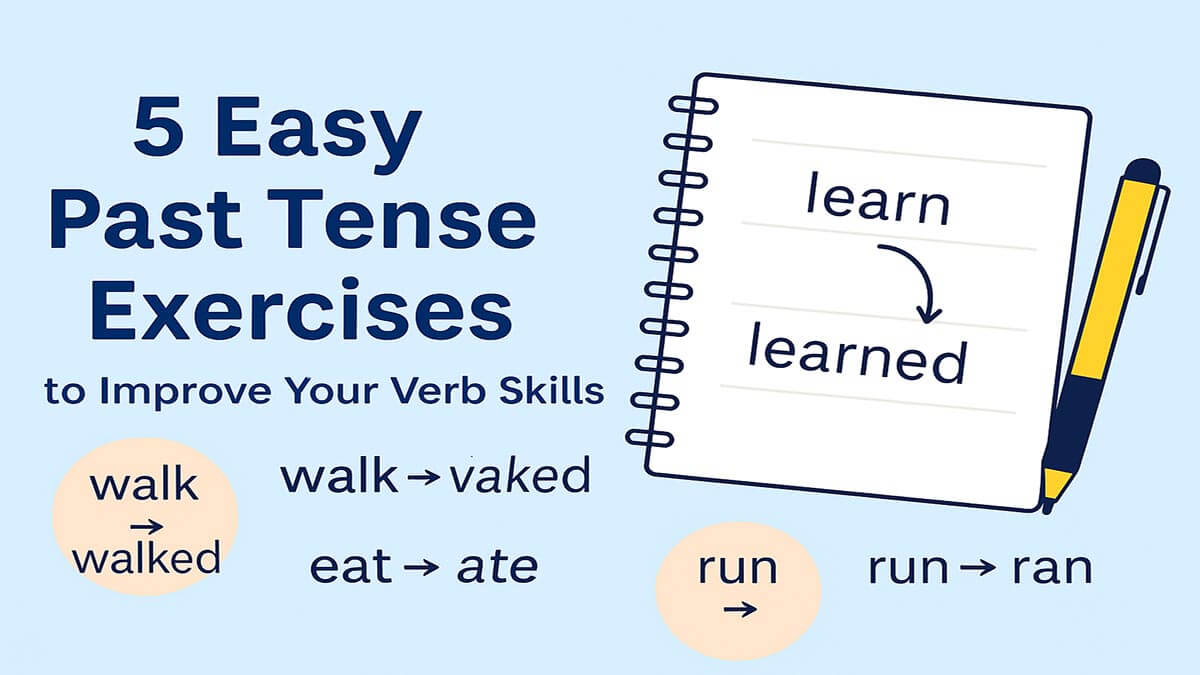Learning and mastering past tense exercises forms can be tricky, especially for English language learners. While it’s one of the first areas learners focus on, it can also cause confusion. Whether you’re a student or an educator, understanding how to properly use the past tense can significantly improve your language proficiency. In this blog post, we’ll explore easy exercises that will help you understand and master past tense verb forms.
Let’s dive into these helpful exercises that will simplify the past tense!
Why are past tense forms important?
The past tense is used to describe actions that have already taken place. Without it, expressing past events becomes challenging. In English, there are three primary types of past tense:
- Simple Past Tense: For actions that happened and were completed in the past (e.g., “I walked”).
- Past Continuous Tense: For actions that were happening at a specific moment in the past (e.g., “I was walking”).
- Past Perfect Tense: For actions completed before another event in the past (e.g., “I had walked”).
Mastering these verb forms ensures you can talk about events, express time, and convey your ideas accurately.
Top 5 easy past tense exercises for learners
These practical exercises will not only help you understand the past tense but also strengthen your verb usage in different contexts.
1. Fill in the blanks (Simple Past Tense example)
This exercise is perfect for beginners who are still learning the basic structure of past tense verbs.
Instructions: Choose the correct past tense verb form to fill in the blanks.
Example:
- Yesterday, I ______ (go) to the store.
- She ______ (finish) her homework last night.
Answer Key:
- Yesterday, I went to the store.
- She finished her homework last night.
Answer:
Walked, Watched, Ate, Visited, Finished, Played, Traveled, Bought, Met, Saw, Built, Read, Studied, Wrote, Spoke, Took, Arrived, Cleaned
2. Correct the mistakes (Past Tense Verbs)
In this exercise, learners will identify and correct errors in sentences using past tense verbs. It encourages attention to detail and reinforces correct verb conjugation.
Example:
- He goed to the park yesterday.
- They was happy to see the movie.
Answer Key:
- He went to the park yesterday.
- They were happy to see the movie.
3. Match the sentence to the past tense form
This activity is great for understanding the difference between the simple past, past continuous, and past perfect.
Instructions: Match each sentence with the correct verb tense.
Example:
- She had already eaten by the time I arrived.
- They were playing football at 6 PM yesterday.
- I visited my grandmother last weekend.
Answer Key:
- Past Perfect: She had already eaten by the time I arrived.
- Past Continuous: They were playing football at 6 PM yesterday.
- Simple Past: I visited my grandmother last weekend.
4. Verb transformation (Regular vs. Irregular Verbs)
This exercise focuses on differentiating between regular and irregular verbs in the past tense.
Instructions: Transform the verbs in parentheses into their correct past tense forms.
Example:
- She ______ (write) letter to her friend the other day.
- They ______ (see) a movie last weekend.
Answer Key:
- She wrote a letter to her friend the other day.
- They saw a movie last weekend.
5. Create your own sentences
This exercise allows learners to practice using different past tense verbs in their own sentences.
Instructions: Write five sentences using different past tense forms (simple past, past continuous, and past perfect).
Example:
- I ate pizza for lunch yesterday. (Simple Past)
- At 7 PM last night, I was watching a movie. (Past Continuous)
- By the time she called, I had finished my homework. (Past Perfect)
Read More:
- 7 Must-Know Greetings & Introductions in Spoken English
- Opposite Words – 200+ for Better English Communication
Tips for past tense exercises – verbs
Practice Regularly: The more you practice, the easier it becomes to remember the correct verb forms.
Learn Irregular Verbs: Unlike regular verbs, irregular verbs don’t follow standard rules. Focus on memorizing the most common ones (e.g., go → went, eat → ate).
Pay Attention to Context: Always consider the context of the sentence to choose between the different past tense forms (simple past, past continuous, and past perfect).
Listen and Repeat: Listening to native speakers or watching English content can help you hear the correct usage of past tense verbs in context.
Conclusion
Mastering the past tense is a crucial step toward fluency in English. By practicing simple exercises like those above, you’ll be able to confidently use past tense verbs in your speaking and writing. Keep practicing regularly, and soon, you’ll notice significant improvements in your language skills.
Whether you’re a learner or an educator, these simple yet effective exercises will help make learning the past tense a fun and rewarding experience.


